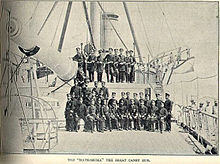Canet gun



The Canet guns were a series of weapon systems developed by the French engineer Canet, who was design engineer for Schneider et Cie of Le Creusot.
320 mm naval guns
Canet developed a 12.6 in (32 cm) naval gun, an extremely powerful weapon for its time. The gun was selected in 1887 to equip the cruisers of the Imperial Japanese Navy designed by Emile Bertin: Matsushima, Itsukushima, and Hashidate.
Their usage was consistent with the French Jeune Ecole philosophy, which advocated using overwhelming firepower (strong guns, torpedoes) on relatively small units.
The guns were only marginally successful during the First Sino-Japanese War, due to a slow rate of fire, and mechanical problems. These large 12 in guns would soon become the industry standard however, with the advent of the 12in all-big-gun Dreadnought battleships around 1905.
Other guns

M.Canet is also known for the development of the Schneider-Canet gun system for 75 mm iron BL mountain guns, and rapid-fire 120 mm and 152 mm guns.[1]
Notes
- ^ "Russian 120 mm/45 (4.7") Pattern 1892". navweaps.com. 2006-03-16. Retrieved 2007-09-09.

